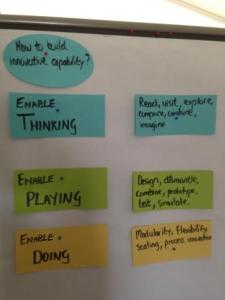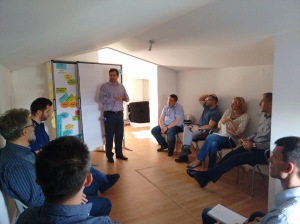I have been developing a new capacity building method and training approach that brings together my work in innovation systems promotion and my work on improving technology and innovation management. I call it “Instigating Innovation”.
I chose “instigating” because it has a more positive ring to it than provocation or incitement. While it is a noun with mainly a positive tone, it is a bit more aggressive than support, enable or encourage or even stimulating. I have been referred to in my past as an instigator of change so I thought this was a good idea.
Why was this effort firstly necessary and secondary so rewarding?
My work on innovation systems is mainly aimed at assisting meso-organizations such as technology transfer centres, research centres and universities to be more responsive to the needs of the private sector. While it only takes a few interviews by a senior decision maker from one of these institutions to a few leading enterprises to get the organization to improve its offering to the private sector, it does not solve the problem that these institutions often needs a continuous process of innovation itself. So while they can respond to the needs of the enterprises (for instance by launching a new service, or making a key technology available, etc), they often are not able to innovate constantly in order to anticipate what they private sector might need in the future.
With my other hat on, working in the private sector to improve the management of technology and innovation is focused on helping individual and on rare occasions, groups or networks of enterprises to formalize or improve their management of innovation. Here my challenge is that most enterprises innovate by accident, or have elements of an innovation management approach in place without knowing it. But it is not systematic nor is it consistent.
So both supporting institutions and enterprises lack some very basic frameworks to focus their existing development and learning processes to ensure not only short term results (new products & services, process improvements, cost reduction, etc) but to also ensure longer term success (playing in the right markets, selecting the right technologies, investing in the right kind of knowledge, partnering with the right people, etc). Furthermore, most enterprises and supporting institutions have something else in common: they often face resource constraints with the most versatile of their staff being involved in problem solving and not thinking about the future and what may be possible sometime down the line.
I set aside most of March and had great fun reading through my collection of articles, books, reports of past missions, and speaking to entrepreneurs and development practitioners I trust. Based on this investigation I decided on the following criteria for instruments to include in the Instigating Innovation module:
- Each instrument or concept must be relevant to both enterprises and meso-level organizations

- Each instrument must provide a very simple framework that can be illustrated on a flipchart
- The simple framework must be usable as a workshop format that allows people to reorganize or explore their current and future practices
- The frameworks must be scalable, both in depth (allowing pointers for a deep dive into an issue) and in width (useable for a product, issue, portfolio or the strategy of the organization as a whole).
- Lastly, I did not want to be the consultant with a project, I want to be the facilitator that enables change and that builds long term sustainability into the organizations that I work with.
This was a very rewarding exercise. Not only do I love reading about innovation, change and technology, I love finding better ways to explain these concepts. It was also great to find a way to connect my work on innovation systems, which often seems abstract, with the tough decisions that the enterprises that I work with must confront and address. I tend to work in the more technical domains dominated by academics, engineers, scientists and manufacturers, so finding a simple yet convincing way to add value to what these clever people do was important.
I will in the next few posts reveal a little bit more of the tools I selected and how it can be used.
Thank you for the EDA team in Bosnia and Herzegovina who motivated me to turn this idea into a capacity building format and who agreed that I try “Instigating Innovation” on their team during my visit to Banja Luka in May 2015!


July 12, 2015 at 2:14 pm
Hi Shawn,
I like the way you want to approach the topic on “Instigating Innovation”. Practitoners in meso institutions require the application of scientific insights into their practice and this is mainly possible through breaking insights down but especially also to work on internal improvements based on concrete workshop reflections that at the same time guide them in realizing and following their own objective. Such approaches require first the demonstrations of the need to innovate internally as well as, second, a guidance how and where to start.
My experience tells me that it is often not about changing the whole organisational structure but getting back to basics:
– reconsidering and reidentifying the reason for existence of the organisation itself through looking again at their objective. Most of meso organisations have been established to overcome market failures, supporting a better access to knowledge resources which individual and group of businesses will not be able to find without high transaction costs
– moving from project funding orientation towards local innovation requirements in the related sectors and businesses. Due to incentives of project funds this perspective often gets out of perspective in many organisations. They mainly focus on getting access to the funding schemes instead of identifying real relevant knowledge requirements in related sectors and businesses.
I think supporting meso institutions in reidentifying and redefining their main role and helping them to be able to preach to businesses what they are themselves also practicing in their own organisations is the right entrance point. This is relevant not only in Bosnia and Herzegowina, but also in Germany as well as in many other parts of the world.
Best, Frank
LikeLike
August 24, 2015 at 2:58 pm
Hi Frank
Thank you for your comment.
I noticed that while everyone talks about how enterprises must innovate, very few people in technology transfer centres, research centres, etc themselves are very innovative in how they support and equip entrepreneurs. That is why I am trying to develop a programme that will benefit both enterprises and these centres.
I apologize for not publishing in almost two months. I have started many drafts that never ended up in a publication.
LikeLike